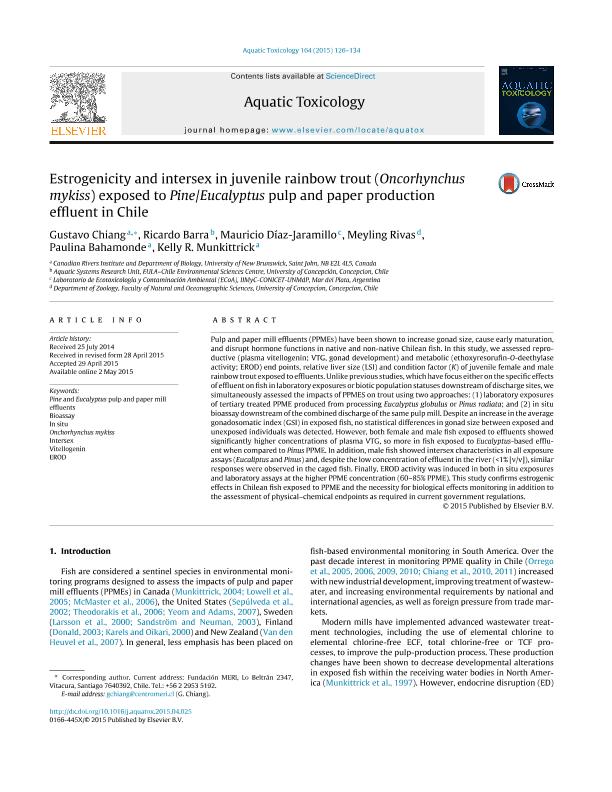Artículo
Estrogenicity and intersex in juvenile rainbow trout (Oncorhynchus mykiss) exposed to Pine/Eucalyptus pulp and paper production effluent in Chile
Chiang, Gustavo; Barra, Ricardo; Diaz Jaramillo, Mauricio Javier ; Rivas, Meyling; Bahamonde, Paulina; Munkittrick, Kelly R.
; Rivas, Meyling; Bahamonde, Paulina; Munkittrick, Kelly R.
 ; Rivas, Meyling; Bahamonde, Paulina; Munkittrick, Kelly R.
; Rivas, Meyling; Bahamonde, Paulina; Munkittrick, Kelly R.
Fecha de publicación:
07/2015
Editorial:
Elsevier Science
Revista:
Aquatic Toxicology
ISSN:
0166-445X
Idioma:
Inglés
Tipo de recurso:
Artículo publicado
Clasificación temática:
Resumen
Pulp and paper mill effluents (PPMEs) have been shown to increase gonad size, cause early maturation, and disrupt hormone functions in native and non-native Chilean fish. In this study, we assessed reproductive (plasma vitellogenin; VTG, gonad development) and metabolic (ethoxyresorufin-. O-deethylase activity; EROD) end points, relative liver size (LSI) and condition factor (K) of juvenile female and male rainbow trout exposed to effluents. Unlike previous studies, which have focus either on the specific effects of effluent on fish in laboratory exposures or biotic population statuses downstream of discharge sites, we simultaneously assessed the impacts of PPMES on trout using two approaches: (1) laboratory exposures of tertiary treated PPME produced from processing Eucalyptus globulus or Pinus radiata; and (2) in situ bioassay downstream of the combined discharge of the same pulp mill. Despite an increase in the average gonadosomatic index (GSI) in exposed fish, no statistical differences in gonad size between exposed and unexposed individuals was detected. However, both female and male fish exposed to effluents showed significantly higher concentrations of plasma VTG, so more in fish exposed to Eucalyptus-based effluent when compared to Pinus PPME. In addition, male fish showed intersex characteristics in all exposure assays (Eucaliptus and Pinus) and, despite the low concentration of effluent in the river (<1% [v/v]), similar responses were observed in the caged fish. Finally, EROD activity was induced in both in situ exposures and laboratory assays at the higher PPME concentration (60-85% PPME). This study confirms estrogenic effects in Chilean fish exposed to PPME and the necessity for biological effects monitoring in addition to the assessment of physical-chemical endpoints as required in current government regulations.
Archivos asociados
Licencia
Identificadores
Colecciones
Articulos(IIMYC)
Articulos de INSTITUTO DE INVESTIGACIONES MARINAS Y COSTERAS
Articulos de INSTITUTO DE INVESTIGACIONES MARINAS Y COSTERAS
Citación
Chiang, Gustavo; Barra, Ricardo; Diaz Jaramillo, Mauricio Javier; Rivas, Meyling; Bahamonde, Paulina; et al.; Estrogenicity and intersex in juvenile rainbow trout (Oncorhynchus mykiss) exposed to Pine/Eucalyptus pulp and paper production effluent in Chile; Elsevier Science; Aquatic Toxicology; 164; 7-2015; 126-134
Compartir
Altmétricas



